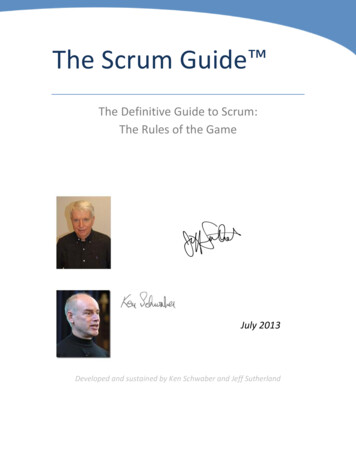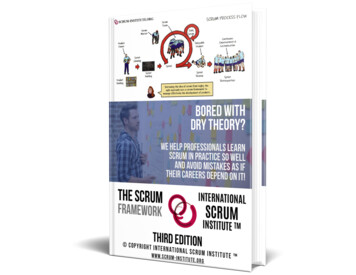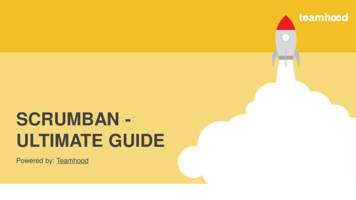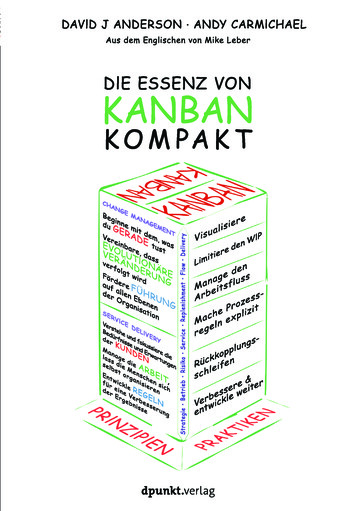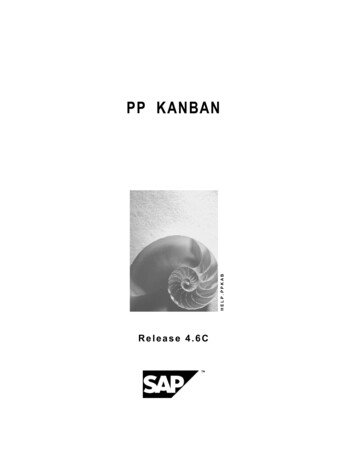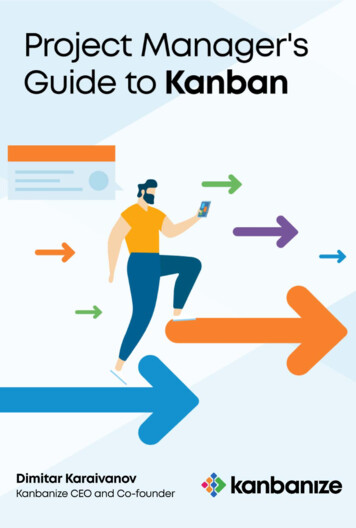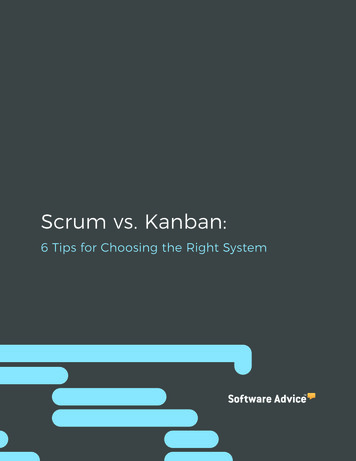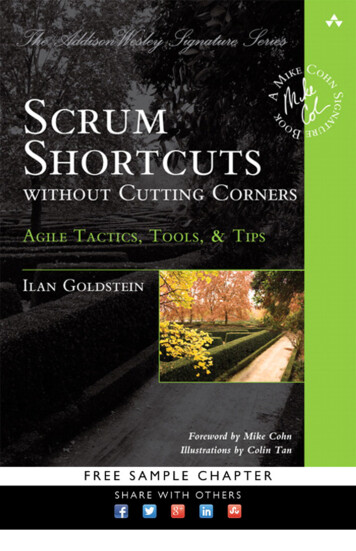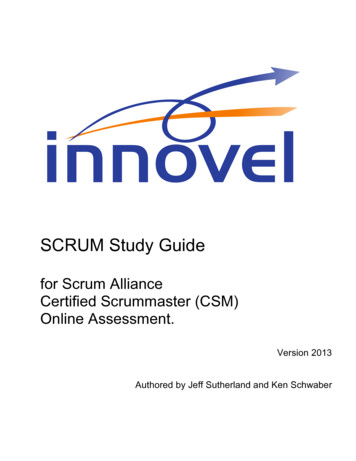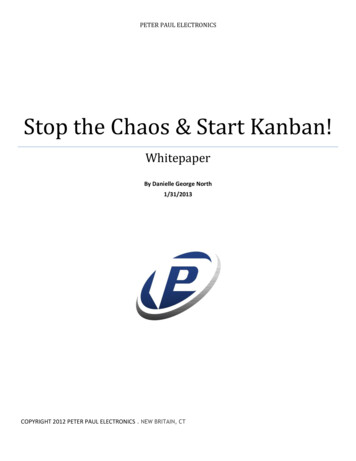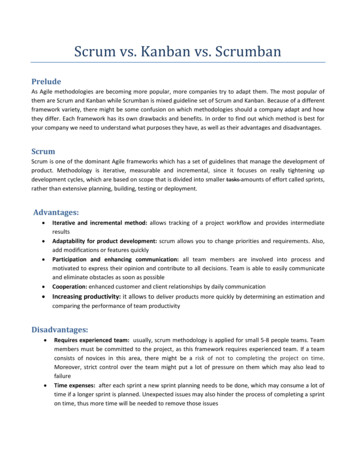
Transcription
Scrum vs. Kanban vs. ScrumbanPreludeAs Agile methodologies are becoming more popular, more companies try to adapt them. The most popular ofthem are Scrum and Kanban while Scrumban is mixed guideline set of Scrum and Kanban. Because of a differentframework variety, there might be some confusion on which methodologies should a company adapt and howthey differ. Each framework has its own drawbacks and benefits. In order to find out which method is best foryour company we need to understand what purposes they have, as well as their advantages and disadvantages.ScrumScrum is one of the dominant Agile frameworks which has a set of guidelines that manage the development ofproduct. Methodology is iterative, measurable and incremental, since it focuses on really tightening updevelopment cycles, which are based on scope that is divided into smaller tasks amounts of effort called sprints,rather than extensive planning, building, testing or deployment.Advantages: Iterative and incremental method: allows tracking of a project workflow and provides intermediateresultsAdaptability for product development: scrum allows you to change priorities and requirements. Also,add modifications or features quicklyParticipation and enhancing communication: all team members are involved into process andmotivated to express their opinion and contribute to all decisions. Team is able to easily communicateand eliminate obstacles as soon as possibleCooperation: enhanced customer and client relationships by daily communication Increasing productivity: it allows to deliver products more quickly by determining an estimation and comparing the performance of team productivityDisadvantages: Requires experienced team: usually, scrum methodology is applied for small 5-8 people teams. Teammembers must be committed to the project, as this framework requires experienced team. If a teamconsists of novices in this area, there might be a risk of not to completing the project on time.Moreover, strict control over the team might put a lot of pressure on them which may also lead tofailureTime expenses: after each sprint a new sprint planning needs to be done, which may consume a lot oftime if a longer sprint is planned. Unexpected issues may also hinder the process of completing a sprinton time, thus more time will be needed to remove those issues
Scope creep: scrum doesn’t have a defined end date. For this reason, a released work may not haveeverything that the stakeholders want and new features are needed to be releasedIteration definition: the scrum estimation is one of the hardest and wasteful parts, as tasks must bewell defined, otherwise estimated project costs and time will not be preciseKanbanKanban is a Lean scheduling manufacture system developed in Japan. A Kanban system utilizes visual cues thatcalculate what to produce, when to produce and how much to produce. Kanban is intended to manage theworkflow and increase performance which aims are to focus the efforts on the items that bring value to the endcustomer and remove waste.Advantages: Reduces waste and scrap: products are manufactured only then when they are needed. In this wayoverproduction is eliminatedInventory level management: Kanban has great inventory practices which smoothens out inventorylevels and eliminates carrying costsFlexibility in production: Kanban ensures you are not stuck with excess inventory if there is a suddendrop in demand for a productIncreases productivity and efficiency: Kanban helps to eliminate the time waste and people are able tofocus on current work. For this reason, making supplies is more accessible and productivity increasesDisadvantages: Less effective in shared-resource situations: suppose that upward production line is made of severalparts. Downsteam line requires make more parts, but it requires a buffer to ensure that downsteamstation does not run out. System becomes more complex because each part needs a separate signalingcardInflexible in demand changes and product mix: Kanban system assumes there is a stable productionplan, where supplier always delivers components for production when it is needed. Therefore, thesystem is not suitable for industries where volumes and mixes of production fluctuateVariability elimination: system can be disrupted by unpredictable and lengthy down times and anyvariability may affect system’s functionsProduction flow: because of the fact that Kanban requires planned weekly and monthly scheduleslinked with day-to-day flexibility, it may not be possible in an environment where multiple or shortlength product types are manufacturedScrumbanScrumban is a mixed methodology of both Scrum and Kanban which increases adaptability and universality forproduct manufacturing and support focused companies.
Advantages: Saving time: Scrumban uses planning on demand technique so there is no need to do estimating orsprint planning. Team plans only when there is a demand. For this reason team members get extra dayof workQuality: saved time on planning allows to focus on quality control and to verify if work item is ill-formed.Saved time allows to control a manufacturing process and to inspect if work is promoted to the readyqueue. If something ill-formed is found, then it gets bounced and troubles are eliminated, then processis repeated once againWaste minimization: Scrumban uses inter-process buffers and flow diagrams to show weaknesses andopportunities of the process. This gives an opportunity to eliminate everything that is not adding valueto the customer1.Applicability of ScrumPractice 1.1 – Create a workspaceTeam members need to know what is going on in a project.Use columns and rows for each sprint to represent project onthe scrum board. Rows on the board depict user stories whichare used as a product backlog. Product backlog is divided intomultiple sprint backlogs. Columns on Scrumboard are used todepict each task card which starts with “To do” column.Generally, then follows other columns named “Work inprocess”, “To verify” and “Done”, they can be nameddifferently. This allows you to follow the workflow of aproject.Practice 1.2 – Plan a sprintAll teams need to have a plan to govern and complete project successfully. Each sprint of a project starts with aplanning meeting. The meeting is extremely important due to goals, quality and scope. During the meeting themain goals and priorities are set by product owner, scrum master and the whole team. The defined aims shouldbe implemented until the end of the sprint.Option No. 1 – one-two week sprintFor each project it is important to choose proper length of a sprint. Duration depends on company specifics. Twoweek duration is ideal because it challenges developers to complete tasks more quickly and reduces
procrastination of those tasks. Furthermore, short sprint reviews allow you to get feedback quicker and work oncontinuous improvement.Option No. 2 – three-four week sprintWith longer sprints it is easier to plan and easier to start. But only disciplined teams will be able to maintain asight of the sprint aims for the first couple weeks. Taking long term sprints there is always a risk that problemswill be exposed too late. Anyway, longer sprints are recommended teams with less fluctuating environment andabsence of support tasks. Also, product based manufacture can adapt longer sprints compared to short termproject based.Practice 1.3 – Create user storiesSelect the work you will be doing for the next sprint in advance.Create task cards for your team members and write detailedinformation for each card. However, if a task card has lots ofinformation, bigger columns should be made to contain severaltasks at once, which may result in a chaotic and confusing board.To make your task board more understandable, choose differentcolors to group task by priorities and importance. Enter short yetinformative titles, estimations and assignations. Bigger tasks shouldbe split into small ones.Practice 1.4 – Work during sprintAfter the sprint is planned and tasks are set, only implementing them is left. Assign a task by yourself or assignthem by drag and drop on the employee who should start working on a particular task. If you have problemswhile working with your own task, add alerts to your task card. Alerts provide the whole team with informationthat you need help. This allows you to get necessary help on time.Practice 1.5 – measure your workflowUse daily burndown charts to see if you are workingaccording to the plan. The vertical axis shows the amountof work remaining at the start of each sprint while thehorizontal axis demonstrates the sprints or one sprinttimeline. The ideal blue line shows the sum of theestimates for all tasks that need to be completed. Redline depicts real situation of your team’s workflow. Theactual work line fluctuates above and below the ideal linedepending on how effective according to timeline theteam is. This allows you to follow whether your team will
complete the project on time.2.Applicability of KanbanPractice 2.1– Visualize workflowCreate a Kanban board with “Input”, “Work In Progress” and “Output” sections. Put task cards on the board andtag important tasks with short descriptions. Use different columns to show your team members which tasks arethe most important and should be started first. Now you have an overview of the whole project that encouragesyour team to seek for the best result.Practice 2.2–Create a workflowBacklog can be split into two columns – backlog and backlog priorities. Now that a backlog is created, stories ortasks can be assigned to team members by the pull principle, where every team member chooses his own taskaccording to themselves. Tasks that are in priorities column are pulled first. Work in progress column can alsohave a lot of other columns with steps like “plan”, “development”, “design”, “draft”, “test”, “deploy”,“integrate” or others. For an even clearer view of the workflow these columns may also have queue for doneitems.Practice 2.3 – WIP limitsAccording to Kanban there should always be work limitsper column to avoid multitasking, which may result in awasted time. WIP limits helps to match team’sdevelopment capacity. If your given column is set to four,then there should be only four tasks being worked on atone time. Those tasks that cannot be completed should bemoved back to backlog and new task is selected frompriority list. Also, there is possibility to establish limits forteams or each person. Work in progress limits are a great
to identify bottlenecks, as each smaller column of work in progress section can also have its own limits. If youare a product development enterprise which has large (lead time) duration, can considerably increase yourcompany’s profitability.Practice 2.4 – Manage performanceKanban uses lead and cycle times to measure performance. Lead time shows how long it takes to complete atask from its request until that request is done and delivered to the end consumer, while cycle time shows howlong a task had spent in production or in work in progress section except queue. Cumulative flow diagram helpsto monitor the progress of all tasks. It shows how many items are still in “to do” section, how many tasks are in“work in progress” and which of them are already finished.Practice 2.5 – Planning routinesKanban does not use a precise planning routine. Either release/iteration planning is used, when a new productor feature set is released, or it uses planning on demand technique, when backlog section runs out of items.Iterations are predefined timeframes in which some part of work or the goal needs to be completed. Kanbandoes not have predefined iterations, because different teams may choose different lengths. Some teams workcontinuously using short timeframes, usually shorter than one week, or choose bigger iterations like quarterlygoals.3.Applicability of ScrumbanPractice 3.1 – Extend boardCreate columns which consist of “To do”, “Work in progress” and “Done”. Column “Work in progress” can bedivided into more sections, then new columns indicate the particular stage a task goes through, thereforeeverybody knows the current situation and tasks are completed as soon as possible. New tasks are put on theboard without assigning them to a particular team member. For this reason team members are able to choosewhich task they would like to work with.Practice 3.2 –Backlog limitMake a list of tasks, put them into backlog and set work in progress limit for this column. Because Scrumbandoes not have regular planning meetings, limit is used to implement planning on demand technique. Team pullsitems from the backlog into the process until it becomes empty, and empty backlog is a trigger which meansthat it is time to plan more tasks. It is better and easier to plan small, aiming only a few tasks per iteration. Youcan also use prioritization on demand technique which provides your team with information which task must betaken next.
Practice 3.3 – Find bottlenecksDivide your work in progress section into smaller columns to implement separate WIP limits. This approachallows you to discover bottlenecks which block the process flow.Practice 3.4 – Metrics performanceScrumban uses average lead and cycle time as its key metrics for performance. If lead and cycle time is undercontrol, then you can understand how long does it take for a task to reach the end consumer, how long it takesto develop and how long does it take to manage management. With these metrics you can predict how long itwill take to provide a certain amount of value or earn some amount of money.
Comparison of Scrum, Kanban, ScrumbanScrumKanbanScrumbanIterations1-4 week sprintsWork routinesPush and pull principlemixed with early bindingto team membersSprint limits total workamountSprint planningContinuous workalongside releases shorterthan one week or biggeriterations like goalsPull principle with latebinding to team membersContinuous work withshort cycles for planningand longer cycles forreleasePull principle with latebinding to team membersScope limitsPlanning routinesEstimationPerformance metricsContinuousimprovementMeetingsRolesTeam membersWork in progress limitscurrent work amountRelease/iterationplanning, demandplanningMust be done before start Optionalof sprintBurndownCumulative flow diagram,lead time cycle timeSprint retrospectiveOptionalSprint planning, dailyscrum, retrospectiveProduct owner, Scrummaster, teamCross-functional teammembersNew items in iterationThe size that can becompleted in sprintForbiddenOwnershipOwned by a teamBoardPrioritizationDefined/reset each sprintThrough backlogRolesScrum master, productowner, teamConstrained processTask sizeRulesFit forCan be avoidedWork in progress limitscurrent work amountPlanning on demand fornew tasksOptionalAverage cycle timeShort Kaizen event as anoptionShort Kaizen eventTeam and other workspecific rolesCross-functional teammembers, specialization isallowedAny sizeTeam and other workspecific rolesSpecialization orpreference to tasksAllowed whenever queueallows itSupports multiple teamsownershipPersistentOptionalAllowed whenever queueallows itSupports multiple teamsownershipPersistentRecommended on eachplanningNot defined, may varyNot defined, may varyOnly a few constraints,flexible processEnterprise maturity forSupport and maintenanceteams working on product teams, continuousor especially projectproduct manufacturingwhich is longer than aAny sizeSlightly constrainedprocessStartups, fast-paceprojects, continuousproduct manufacturing
ContinuousimprovementMeetingsRolesTeam membersyearSprint retrospectiveSprint planning, dailyscrum, retrospectiveProduct owner, Scrummaster, teamCross-functional teammembersNew items in iterationThe size that can becompleted in sprintForbiddenOwnershipOwned by a teamTask sizeOptionalCan be avoidedShort Kaizen event as anoptionShort Kaizen eventTeam and other workspecific rolesCross-functional teammembers, specialization isallowedAny sizeTeam and other workspecific rolesSpecialization orpreference to tasksAllowed whenever queueallows itSupports multiple teamsownershipAllowed whenever queueallows itSupports multiple teamsownershipAny sizeScrumScrum is the most restrictive method of scrum, kanban and scrumban. Scrum is a constrained process wheretasks are assigned to each team member (all tasks might be bounded by deadlines), while Kanban and Scrumbanuses pull technique. Scrum works well for large projects, because work is organized in sprints (usually 1-4 weeks)which are planned by all scrum team members. After one sprint ends, new sprint is planned, therefore theboard is reset for each sprint. Unlike the other two methodologies Scrum has predefined roles like Scrummaster, product owner and developer team. Scrum teams are cross-functional and tracks their workflow usingburndown charts and have daily meetings where each member defines the current situation of his work. Largerenterprises, with larger projects usually use scrum to achieve effectiveness in a working process.KanbanKanban is focused on continuous delivery of completed work or part of work. One of the most recognizablefeatures of Kanban is WIP limits, which is used to reduce the amount of tasks that can be worked on at one time.As the work is continuous, the board stays persistent, only the tasks change. Workflow happens through a pullprinciple, where tasks are assigned after they went to the backlog or backlog priorities sections. New items canbe added to the backlog whenever WIP limits allow it. Just like in Scrum, team members are working individuallyand may swarm a task if there is a need for it, however Kanban doesn’t need daily meeting. There are no rolesfor team members, but they can choose specialization. Kanban uses cumulative flow diagrams, lead and cycletimes to measure performance and the planning is done after each release/iteration or by planning on demandprinciple. Kanban doesn’t impose strict constraints, process is more flexible. Therefore it fits best for support,maintenance teams or continuous product manufacturing.
ScrumbanScrumban uses mixed techniques of both methodologies. It combines basic features of Scrum and flexibility ofKanban. Scrumban has a slightly constrained process where prioritization is optional, but it is recommendedduring each planning and planning is done by Kaizen events. Scrumban uses planning on demand principle to fillthe backlog and tasks are assigned only by the pull system like in Kanban. Also, just like in Kanban, the boardstays persistent, while only the tasks and their priorities change. In Scrumban the work is usually focused moreon planning than releasing, while in Scrum planning is done after each sprint, Scrumbans planning is done onlyon demand. This method is mostly used for fast-paced process like startups or projects which require continuousproduct manufacturing, where the environment is dynamic.Final WordTaking everything into account, scrum, kanban and scrumban methods are quite distinct, as there are quite afew of them, one should understand the basic principles of all of them in order to find the best solution for theirown specific needs. Agile methodologies will always benefit companies when they are applied in the right way.The most important thing is to choose a technique which fits your needs and requirements. These practiceswon’t solve all of your problems, but definitely will make your working process more effective and productive.
Kanban Kanban is a Lean scheduling manufacture system developed in Japan. A Kanban system utilizes visual cues that calculate what to produce, when to produce and how much to produce. Kanban is intended to manage the workflow and increase performance which aims are to f
